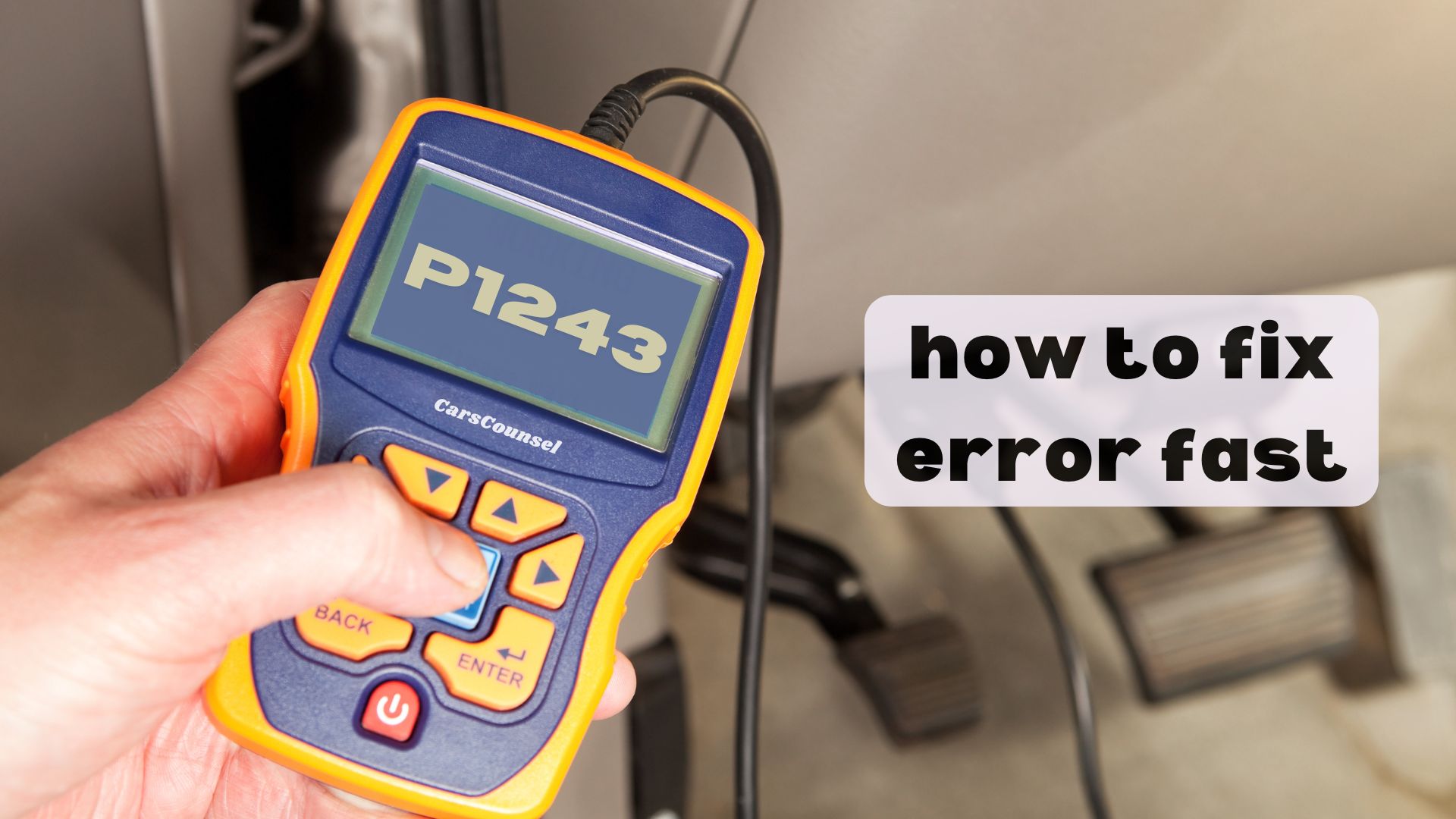You’re cruising down the highway, feeling confident in your vehicle’s performance, when suddenly the check engine light flickers on, casting a shadow of doubt over your trusty ride. The P1243 code appears, signaling a problem with the second fuel pump or a ground fault – a issue that can’t be ignored.
As you ponder the implications, you’re left wondering what’s causing the fault and how to fix it. Is it a faulty fuel pump, a corroded connection, or something more sinister? The journey to resolving this fault code begins with understanding its causes and symptoms, and it’s time to get to the bottom of it.

Quick Navigation
Key Takeaways
- The P1243 code indicates a problem with the second fuel pump or a related ground fault in vehicles equipped with dual fuel pumps.
- A faulty second fuel pump or ground fault can cause poor engine performance, rough idling, and surging while driving.
- Common causes of failure include a failed second fuel pump, ground fault in the fuel pump circuit, and malfunctioning fuel pump control module or electrical issues.
- Diagnosing the faulty pump requires a scan tool, inspection of the fuel pump circuit, and testing of the fuel pump control module and electrical connections.
- Repairing or replacing the faulty second fuel pump, addressing wiring issues, and verifying the new pump’s compatibility with the vehicle’s make and model can resolve the issue.
Code P1243 Overview
When your vehicle’s onboard computer triggers the P1243 code, it’s a sign that there’s a problem with the second fuel pump or a related ground fault.
This code specifically points to an issue with the secondary pump in vehicles equipped with dual fuel pumps.
The fuel pump has a rich history. It plays a vital role in delivering fuel from the tank to the engine, ensuring proper fuel pressure and flow for combustion.
As part of regular vehicle maintenance, it’s essential to monitor the fuel pump’s performance to prevent issues like the P1243 code.
Ignoring this code can lead to performance problems, decreased fuel economy, and even long-term damage to your vehicle.
Common Causes of Failure
Faulty components and electrical issues are the primary culprits behind the P1243 code.
You’ll typically find that a failed second fuel pump is the main cause, leading to pump failure and potentially fuel leaks.
Another common issue is a ground fault in the fuel pump circuit, which often results from wiring problems or corrosion.
Additionally, a malfunctioning fuel pump control module or electrical issues in the fuel system can also trigger the code.
It’s essential to identify the root cause of the problem to prevent further damage to your vehicle.
Identifying P1243 Symptoms
A faulty second fuel pump or ground fault can significantly impact your vehicle’s performance, leading to a range of noticeable symptoms.
As the fuel pump failure progresses, you may experience poor engine performance, rough idling, and surging while driving.
Engine stalling or difficulty starting the vehicle are also common symptoms of a faulty second fuel pump or ground fault.
Additionally, you may notice a decrease in fuel economy and the Check Engine light may illuminate on your dashboard.
It’s essential to address these symptoms promptly to prevent further damage to your vehicle’s engine and fuel system.
Diagnosing the Faulty Pump
Diagnosing the faulty second fuel pump requires a systematic approach to pinpoint the exact cause of the problem.
You’ll need to identify the root cause of the issue to prevent future failures and guarantee proper fuel pump maintenance.
To do this, follow these steps:
- Use a scan tool to retrieve the trouble code and monitor live data to understand the fuel pump’s behavior.
- Inspect the fuel pump circuit for signs of damage, corrosion, or wear on the wires, connectors, and components.
- Test the fuel pump control module to confirm it’s functioning correctly and providing the proper voltage to the fuel pump.
- Check the fuel pump’s electrical connections for any signs of corrosion or wear that could be causing a ground fault.
Repairing or Replacing Components
With the faulty second fuel pump or ground fault identified, it’s time to take corrective action by repairing or replacing the affected components.
You’ll need to inspect the fuel pump, wiring, and connections for signs of damage, corrosion, or wear. If the pump is faulty, you’ll need to replace it to restore proper fuel flow and pressure.
Pump replacement is vital to maintaining fuel efficiency and preventing long-term engine damage. Verify the new pump is compatible with your vehicle’s make and model.
Additionally, any wiring issues or ground faults should be addressed to prevent future problems. By replacing or repairing the faulty components, you’ll be able to clear the P1243 code and get your vehicle running smoothly again.
Fuel Pump Control Module Issues
The fuel pump control module‘s malfunction can significantly contribute to the P1243 code, as it regulates the fuel pump’s operation and guarantees proper fuel pressure and flow.
When the module fails, it can prevent the fuel pump from functioning correctly, leading to problems with fuel delivery and engine performance.
- Faulty module programming can cause the fuel pump to malfunction or not turn on at all.
- Corrosion or wear on the fuel pump relays can disrupt the electrical signal, preventing the pump from operating correctly.
- A malfunctioning module can also cause the fuel pump to run continuously, leading to increased fuel consumption and wear on the pump.
- In some cases, the module may not be able to detect faults in the fuel system, making it difficult to diagnose and repair issues.
Ground Fault Troubleshooting
When tackling a P1243 code, you’ll need to thoroughly investigate the possibility of a ground fault in the fuel pump circuit.
Ground fault detection is vital in this process, as it can help you identify the source of the issue. Start by using electrical surge analysis to test the fuel pump circuit for any signs of electrical surges or anomalies.
This will help you determine if the ground fault is caused by a faulty component or a wiring issue. Next, use a multimeter to measure the voltage and resistance in the circuit, looking for any unusual readings that could indicate a ground fault.
Wiring and Connection Inspection
Inspecting the wiring and connections is a crucial step in diagnosing the P1243 code, as issues in this area can cause a range of problems, from intermittent faults to complete system failures.
You’ll want to carefully examine the wiring and connections related to the second fuel pump, looking for signs of damage, corrosion, or wear.
Check for:
- Wire corrosion or fraying can lead to electrical shorts or open circuits.
- Loose or corroded connections can disrupt fuel pump operation.
- Fuel leaks or signs of fuel seepage around connections or wiring.
- Chafed or pinched wires can cause electrical faults or short circuits.
Estimated Repair Costs
With the diagnosis and inspection complete, you’re likely wondering what the estimated repair costs will be to fix the P1243 code. The cost of repairing a second fuel pump fault or ground fault related to the fuel pump can vary depending on the extent of the problem, the vehicle make and model, and labor rates in the area.
| Repair Component | Average Cost | Labor Rate |
|---|---|---|
| Fuel Pump Replacement | $200-$500 | $80-$150/hour |
| Wiring Repair/Replacement | $100-$300 | $80-$150/hour |
| Fuel Pump Control Module | $300-$600 | $80-$150/hour |
On average, the repair costs for this issue can range from $200 to $800, including parts and labor. For a more accurate estimate, it is recommended to consult a local mechanic or dealership.
Resolving the P1243 Code
Now that you’ve diagnosed the P1243 code and identified the root cause, it’s time to take corrective action to resolve the issue.
To guarantee a successful repair, follow these steps:
- Replace the faulty second fuel pump: Install a new pump that meets the manufacturer’s specifications to restore proper fuel pressure and flow.
- Repair or replace faulty wiring: Inspect the fuel pump circuit for signs of damage, corrosion, or wear, and repair or replace it as needed.
- Perform Fuel Pump Maintenance: Check the fuel filter, fuel tank, and fuel lines for any blockages or restrictions that could affect fuel flow.
- Consider Fuel System Upgrades: If your vehicle is prone to fuel pump issues, consider upgrading to a high-performance fuel pump or fuel system to prevent future problems.
More OBD-II Codes
Frequently Asked Questions
Can a Faulty Oxygen Sensor Trigger the P1243 Code?
You’re wondering if a faulty oxygen sensor can trigger the P1243 code. No, it’s unlikely, as sensor failure typically doesn’t affect the fuel pump circuit. The issue is more likely related to the fuel pump relay or wiring, so focus on inspecting those components first.
Will a P1243 Code Affect My Vehicle’s Emissions?
As you fire up your ride, bear in mind that a faulty fuel pump is like a knight without armor – it leaves your engine vulnerable. A P1243 code may not directly impact emissions testing, but it can decrease fuel efficiency, leading to higher emissions and potentially affecting your vehicle’s overall performance.
Is It Safe to Drive With the P1243 Code Illuminated?
When driving with a faulty second fuel pump, you risk low fuel pressure, engine stalling, and poor performance, increasing driving risks, so it’s not recommended to continue driving, as it may cause further damage or safety issues.
Can a Low Fuel Level Cause the P1243 Code to Appear?
Curiously, 75% of fuel pump failures occur due to contamination or debris. You’re wondering if a low fuel level can trigger the P1243 code. The answer is no, as a low fuel level doesn’t directly affect fuel pressure or create fuel leakage, which are more likely causes of the code.
Will a Tune-Up or Oil Change Fix the P1243 Code?
You won’t fix the P1243 code with a tune-up or oil change, as they don’t address faulty fuel pump relays, wiring issues, or ground faults; instead, inspect and test the fuel pump circuit, relay, and wiring to identify the root cause.
Conclusion
You’ve finally diagnosed the pesky P1243 code, but don’t think you’re out of the woods just yet. While ignoring it might seem like an easy way out, it’ll only lead to long-term engine damage and a lighter wallet. On the flip side, tackling the issue head-on will restore your ride’s performance, fuel efficiency, and your peace of mind. So, take a deep breath, roll up your sleeves, and get ready to tackle that faulty fuel pump or ground fault – your car (and your wallet) will thank you.

